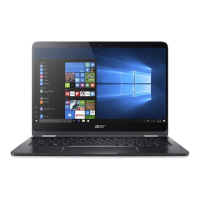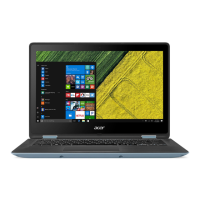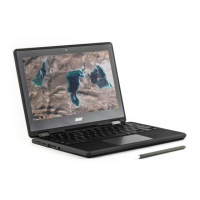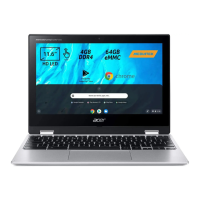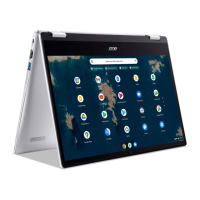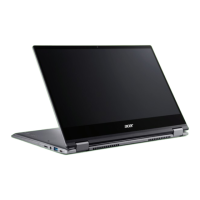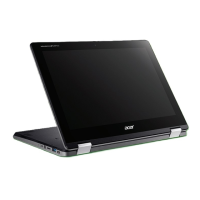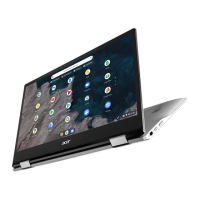Do you have a question about the Acer Spin 5 and is the answer not in the manual?
Guides for setting up and using the Acer notebook.
Essential advice for maintaining the computer's condition and longevity.
Advice on protecting the computer from damage and environmental factors.
Instructions for maintaining the AC adapter for safe use.
Precautions and best practices for safe and optimal battery performance.
Information regarding the computer's built-in rechargeable battery.
Identifies components visible on the computer's screen.
Details the layout and function of the keyboard keys.
Describes the ports and connectors located on the left side of the notebook.
Describes the ports and connectors located on the right side of the notebook.
Identifies components and features on the back of the computer.
Illustrates components on the bottom of the notebook.
Explains the function of keys like Caps Lock and Num Lock.
Describes keys that activate specific functions or features.
Details key combinations that perform specific commands or actions.
Explains keys that perform Windows-specific functions.
Outlines various finger movements to control the touchpad.
Guides users on customizing touchpad behavior and sensitivity.
Steps to back up personal files for data protection and recovery.
Instructions to back up network drivers for potential reinstallation.
Process for creating a full system backup for factory reset.
Procedures to restore the computer to its default or previous state.
Guide on resetting the PC while preserving personal files.
Steps to perform a complete factory reset, removing all data.
How to activate or deactivate the Bluetooth function on the computer.
Instructions for pairing and connecting Bluetooth devices.
Steps to connect the computer to a Wi-Fi network.
How to use a physical security lock to prevent theft.
Information on setting up passwords for system security and access control.
Procedures and tips for entering passwords correctly to access the system.
Guide on setting up and using the fingerprint scanner for login.
How to configure the order in which the computer boots from different devices.
Instructions for setting BIOS passwords for system security.
Tips and settings to optimize power consumption and extend battery life.
Guide to turn off fast startup for reduced battery drain.
Information about the battery's properties and behavior.
Procedures for charging the computer's battery.
Steps for initial setup and calibration of a new battery.
Strategies to maximize operational time on battery power.
How to view the current charge status of the battery.
Actions to take when the battery charge is critically low.
Steps to safely detach the computer from external accessories.
Tips for transporting the computer over short distances.
Procedures for getting the computer ready for travel.
List of essential items to carry when traveling with the computer.
Important advice and precautions for traveling with the device.
Specific guidelines for taking the computer across country borders.
Information about USB ports, types, and usage.
Details on the Thunderbolt 4 port for high-speed connectivity.
How to insert and use SD cards with the computer.
Information on connecting external monitors, headphones, and microphones.
Explanation of the HDMI interface for audio/video connections.
Common issues and their solutions for computer usage.
Pointers to help users get started with the Windows 10 operating system.
General advice and methods for solving computer problems.
Information on common error messages and their corrective actions.
Essential steps to safeguard the computer against online threats.
Guidance on selecting an ISP for internet connectivity.
Overview of different methods for connecting to the internet.
Information on setting up wired and wireless networks.
Advice on using security software to protect against malware and cybercrime.
Tactics and best practices to prevent online threats and data theft.
| Graphics | Intel Iris Xe Graphics |
|---|---|
| Touchscreen | Yes |
| Convertible | Yes |
| Processor | Intel Core i5 or i7 |
| RAM | 8GB or 16GB |
| Storage | 256GB, 512GB, or 1TB |
| Operating System | Windows 10 or Windows 11 |
| Battery Life | Up to 15 hours |
| Weight | 2.65 lbs (1.2 kg) |
| Ports | 1 x USB-A, HDMI, headphone jack |
| Wireless | Wi-Fi 6, Bluetooth 5.0 |
